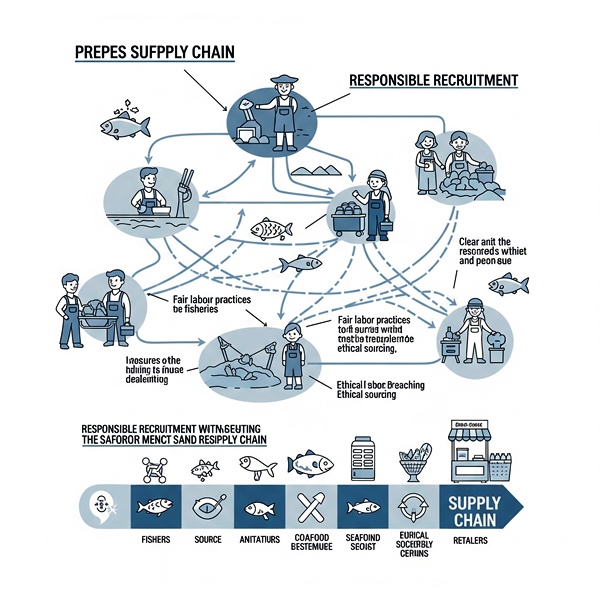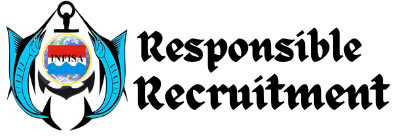
The journey of seafood from the ocean or farm to our plates is a complex one, involving a network of dedicated individuals and businesses. From fishers and farmers to traders, processors, distributors, and finally, supermarkets, each player has a vital role in ensuring the seafood we consume is safe, high-quality, and sustainably sourced. Let’s dive into the important roles of often-overlooked fish traders (middlemen) and the highly visible supermarkets, the significant impact of responsible recruitment programs, and how we can guarantee seafood traceability right to the consumer’s hands.
The Pivotal Roles of Fish Traders (Middlemen) and Supermarkets
Fish Traders/Middlemen: The Unseen Connectors
Often working behind the scenes, fish traders or “tengkulak” are crucial links in the seafood supply chain, especially for smaller-scale fisheries:
- Aggregators: They gather catches from numerous small-scale fishers or farmers who might otherwise struggle to access larger markets due to limited individual production.
- Initial Distributors: Traders frequently act as the first bridge, connecting producers (fishers/farmers) with broader markets, including processing plants or supermarkets.
- Early Logistics Providers: They typically manage the initial transportation of seafood from landing sites or farms to local markets or larger collection points.
- Price Setters (Initial Stage): Traders play a role in determining prices at the fisher or farmer level. This can be a point of contention if transparency and balanced bargaining power are lacking.
- Capital Providers (Occasionally): In some instances, traders may provide capital loans to fishers for their operations, which can sometimes lead to dependent, patron-client relationships.
Supermarkets: The Consumer-Facing Gatekeepers
Supermarkets are one of the primary points where consumers purchase seafood, giving them significant influence and responsibility:
- Final Distributors to Consumers: With their extensive market reach, supermarkets are key in making seafood accessible to a vast number of consumers.
- Standard Setters for Quality and Safety: Supermarkets often enforce strict quality, food safety, and hygiene standards for the products they sell, including seafood. This can drive better practices throughout the supply chain.
- Product Information Providers: They have the potential to offer consumers vital information about product origin, fishing/farming methods, and sustainability labels.
- Drivers of Sustainable Product Demand: As consumer awareness grows, supermarkets can play a proactive role in promoting and selling seafood sourced responsibly and sustainably.
- Stock and Cold Chain Management: Supermarkets are responsible for maintaining seafood quality through effective stock management and a consistent cold chain to prevent spoilage and bacterial growth.
The Impact of Responsible Recruitment Programs
Responsible recruitment programs are critically important in the seafood industry. They are essential in preventing forced labor, human trafficking, and other poor labor practices that unfortunately still persist in some parts of the sector, particularly in capture fisheries. The positive impacts are far-reaching:
- Protection of Workers’ Human Rights: Ensuring workers are recruited fairly, transparently, and ethically, with no recruitment fees charged to them, clear and understandable employment contracts, and safe, decent working conditions.
- Improved Worker Welfare: Better working conditions, fair wages, and humane working hours directly contribute to enhanced worker well-being.
- Reduced Reputational Risk for Companies: Businesses implementing responsible recruitment are shielded from reputational damage associated with human rights abuses in their supply chains.
- Enhanced Productivity and Quality: Well-treated workers tend to be more motivated, loyal, and productive, which can, in turn, improve product quality.
- Meeting International Market Demands: Many international markets, especially in developed countries, increasingly demand proof that imported products are produced ethically and responsibly.
- Supporting Social Sustainability in the Industry: Responsible recruitment is a cornerstone of achieving social sustainability within the seafood sector.
Ensuring Seafood Traceability to the Consumer
Traceability is the ability to track seafood movement through all stages of production, processing, and distribution. It’s crucial for food safety, sustainability, and combating Illegal, Unreported, and Unregulated (IUU) fishing. Here’s how it can be ensured:
- Data Identification and Recording at Each Stage:
- Fishers/Farmers: Recording information like catch/harvest location, time, species, gear used, and volume.
- Traders/Collectors: Documenting who the product was bought from, when, where it’s going next, and handling methods (e.g., use of ice).
- Processors: Noting raw material origin, processing steps (e.g., filleting, freezing), production dates, and batch codes.
- Distributors and Supermarkets: Recording where products are received from, storage conditions, and sale dates.
- Leveraging Technology:
- Barcodes and QR Codes: Enabling easy product tracking at every supply chain point. Consumers can scan QR codes for product origin information.
- RFID (Radio-Frequency Identification): RFID tags can provide real-time tracking information.
- Blockchain: This technology offers a secure, transparent platform to record every transaction and product movement, making it difficult to alter or falsify.
- Electronic Data Management Systems: Specialized software to manage traceability data efficiently.
- Certifications and Standards:
- Third-Party Certifications: Bodies like the Marine Stewardship Council (MSC) for sustainable wild fisheries or the Aquaculture Stewardship Council (ASC) for responsible aquaculture often have stringent traceability requirements.
- Government Standards: Many countries have regulations for seafood traceability to combat IUU fishing and ensure food safety.
- Supply Chain Collaboration and Transparency:
- Inter-Party Cooperation: It’s vital for all supply chain stakeholders to collaborate and share data transparently.
- Consumer Engagement: Providing consumers with access to traceability information can build trust and drive demand for traceable products.
- Training and Capacity Building:
- Educating fishers, farmers, and other business operators on the importance of traceability and how to implement effective recording systems.
The Interconnectedness: Traders, Supermarkets, Responsible Recruitment, and Traceability
These elements are not isolated; they are deeply intertwined:
- Commitment to Sustainability: Traders and supermarkets committed to sustainability are more likely to partner with suppliers who implement responsible recruitment practices. They can leverage their purchasing power to drive positive change.
- Verifying Ethical Claims: Robust traceability can help verify claims related to fair labor practices. If a product can be traced back to a specific vessel or farm, working conditions there are easier to monitor and verify.
- Informing Consumers: Supermarkets can use traceability systems to provide consumers with information not just about the geographic origin of the fish, but also its social aspects, such as whether it comes from sources free of forced labor.
- Pillars of an Ethical Supply Chain: Responsible recruitment programs and strong traceability systems are critical components of an ethical and sustainable seafood supply chain. They mutually support the creation of transparency and accountability.
By fostering commitment from all parties, including fish traders and supermarkets, implementing responsible recruitment, and establishing effective traceability systems, the seafood industry can navigate towards a future that is fairer, more transparent, and sustainable for everyone.

